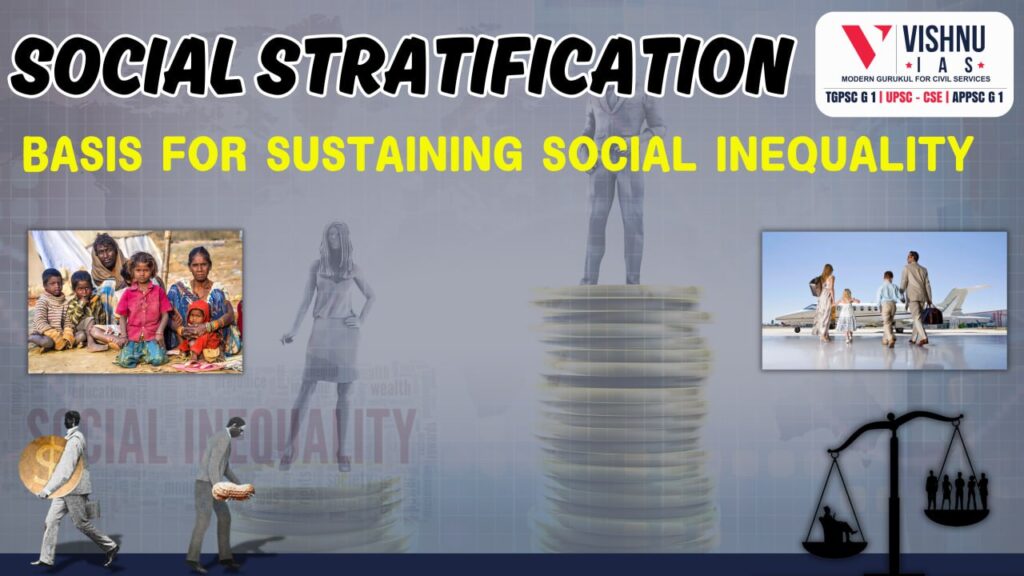Social Stratification and Inequality
- Introduction: add meaning of the concept of social stratification
- Body: add the comprehensive analysis about the concept of social stratification as a basis for sustaining social inequality with critical evaluation.
- Conclusion: add its contemporary relevance and significance.
INTRODUCTION
Social stratification refers to the hierarchical arrangement of individuals in a society based on various factors such as wealth, income, education, occupation, and social status. This system of ranking creates layers or strata within society, leading to unequal access to resources and opportunities.
BODY
Social Stratification as a Basis for Sustaining Social Inequality
Here’s a critical examination of how social stratification sustains social inequality:
Definition and Mechanisms of Social Stratification
- Institutionalized Inequality:
- Social stratification is an institutionalized system of social inequality, where social differentiation based on characteristics like class, race, gender, and occupation becomes the basis for unequal distribution of resources.
- This system determines who gets what, when, and why, reinforcing existing power structures and perpetuating inequality.
- Types of Stratification Systems:
- Caste System: A rigid form of stratification where social status is inherited and immutable. For example, the caste system in India historically determined individuals’ social roles and access to resources.
- Class System: A more flexible system where social mobility is possible, but still limited by factors such as education, wealth, and social connections. For instance, the class system in the United States allows for upward mobility, but significant barriers remain.
Sustaining Social Inequality
- Economic Inequality:
- Social stratification leads to economic inequality by concentrating wealth and resources in the hands of a few. The upper classes have greater access to high-paying jobs, quality education, and investment opportunities, while the lower classes struggle with low wages and limited access to resources.
- Example: The wealth gap in many countries, where the top 1% controls a significant portion of the nation’s wealth, exemplifies how stratification sustains economic inequality.
- Educational Inequality:
- Access to quality education is often determined by social class. Children from affluent families can afford better schools, tutoring, and extracurricular activities, giving them a competitive edge over those from lower-income families.
- Example: In the United States, disparities in school funding based on local property taxes result in significant differences in educational quality between wealthy and poor neighbourhoods.
- Occupational Inequality:
- Social stratification affects occupational opportunities and career advancement. Higher social strata have better access to prestigious and well-paying jobs, while lower strata are often confined to low-status, low-paying occupations.
- Example: The glass ceiling effect, where women and minorities face barriers to advancement in corporate hierarchies, illustrates how stratification perpetuates occupational inequality.
Critique of Social Stratification
- Functionalist Perspective:
- Functionalists argue that social stratification is necessary for the functioning of society. It ensures that the most qualified individuals fill the most important roles, providing motivation for people to strive for higher positions.
- Critique: This perspective overlooks the inherent inequalities and barriers that prevent equal opportunities for all individuals, perpetuating social injustice.
- Conflict Perspective:
- Conflict theorists view social stratification as a tool for the dominant classes to maintain their power and control over resources. It creates and sustains inequality by exploiting and oppressing the lower classes.
- Critique: While highlighting the power dynamics and inequalities, this perspective may underestimate the complexity of social mobility and the potential for change within stratified systems.
- Symbolic Interactionist Perspective:
- Symbolic interactionists focus on the micro-level interactions and how social stratification affects individuals’ self-concepts and daily lives. They examine how social status and roles are constructed and maintained through social interactions.
- Critique: This perspective provides valuable insights into the lived experiences of individuals but may lack a broader analysis of the structural factors sustaining inequality.
CONCLUSION
Social stratification is a fundamental aspect of societal organization that sustains social inequality through various mechanisms, including economic, educational, occupational, and health disparities. While different theoretical perspectives offer insights into its functions and consequences, it is crucial to address the systemic barriers and power dynamics that perpetuate inequality. Understanding and challenging these structures is essential for creating a more equitable society.
Anthropology Full Course at Vishnu IAS Academy
What does Course Offer?
- 4 Months (250+ Class Hours)
- Online (App + Web) / Offline / Hybrid Mode of Classes
- Live + Recorded Videos Access For 1 Year
- 2 Hour Live Class From Monday to Saturday (1.5 Hours for Class + ½ Hour for Doubt Solving)
- Foundation to Advanced Level of Teaching
- Simple and Integrated Content
- One Stop Solution Books
- Regular Value Added Content
- Current Affairs & Case Studies Modules
- Daily Answer Writing Practice
- Weekly Grand Tests On Sundays & Evaluation With Guidance and Topper Will be Rewarded
- 500+ Model Answers
- 9 AM – 9 PM Support System
- Free GS Current Affairs
- Free Interview Guidance for Anthropology


